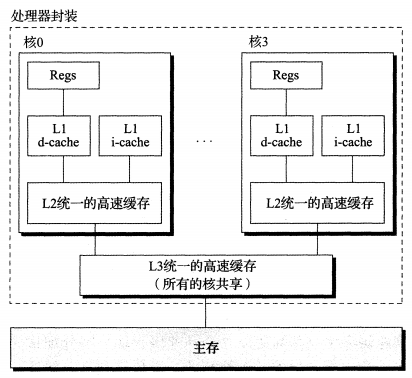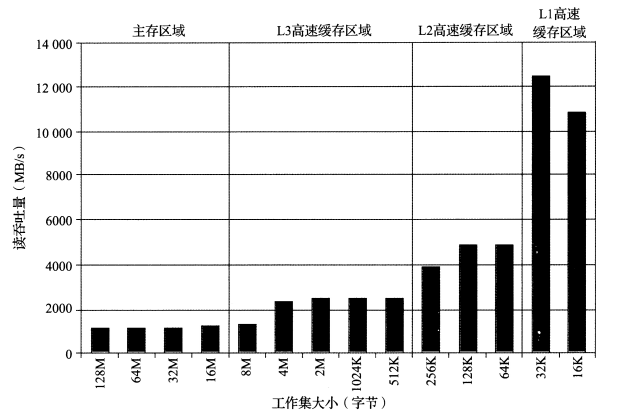高速缓存与局部性原理
1 概述
一个编写良好的程序常常具有局部性原理。这儿的局部性表现为两方面:时间局部性和空间局部性。时间局部性即为,如果一个内存位置被引用,则在不久的将来,它很有可能将被再次引用;空间局部性即为,如果一个内存位置被引用,则在不久的将来,它附近的内存位置很可能被引用。
正是因为程序局部性原理,计算机设计者增加了高速缓存存储器这个硬件,从而提高程序对主存的访问速度。一般来说,高速缓存设计为3层,容量依次增大,访问速度依次减小。如果没有在高速缓冲中命中数据,程序再访问主存获取数据。
2 真实的高速缓存
下图给出了Intel Core i7处理器的高速缓存层次结构。每个CPU芯片有四个核,每个核有自己私有的L1 i-cache(指令cache)、L1 d-cache(数据cache)和L2统一的高速缓存。所有的核片共享片上L3统一的高速缓存。

L1高速缓存的访问速度几乎和寄存器一样快;L2高速缓存的访问时间大约为10个时钟周期;L3高速缓存的访问时间大约为50个时钟周期。

3 高速缓存对程序性能的影响
3.1 测试程序
编写一个程序,这个程序通过循环语句发出读请求,那么,测量出的读吞吐量可以显示出高速缓存的存储性能。
test()通过以步长stride扫描一个数组的头elems个元素来产生读序列。
run()的参数size和stride允许控制产生的读序列的时间和空间局部性的程序。size越小,得到的工作集越小,程序的时间局部性越好;stride越小,扫描的步长越小,程序的空间局部性越好。run()调用test(),并返回测量出的读吞吐量。
/* mountain.c - Generate the memory mountain. */
/* $begin mountainmain */
#include <stdlib.h>
#include <stdio.h>
#include "fcyc2.h" /* measurement routines */
#include "clock.h" /* routines to access the cycle counter */
#define MINBYTES (1 << 14) /* First working set size */
#define MAXBYTES (1 << 27) /* Last working set size */
#define MAXSTRIDE 15 /* Stride x8 bytes */
#define MAXELEMS MAXBYTES/sizeof(long)
/* $begin mountainfuns */
long data[MAXELEMS]; /* The global array we'll be traversing */
/* $end mountainfuns */
/* $end mountainmain */
void init_data(long *data, int n);
int test(int elems, int stride);
double run(int size, int stride, double Mhz);
/* $begin mountainmain */
int main()
{
int size; /* Working set size (in bytes) */
int stride; /* Stride (in array elements) */
double Mhz; /* Clock frequency */
init_data(data, MAXELEMS); /* Initialize each element in data */
Mhz = mhz(0); /* Estimate the clock frequency */
/* $end mountainmain */
/* Not shown in the text */
printf("Clock frequency is approx. %.1f MHz\n", Mhz);
printf("Memory mountain (MB/sec)\n");
printf("\t");
for (stride = 1; stride <= MAXSTRIDE; stride++)
printf("s%d\t", stride);
printf("\n");
/* $begin mountainmain */
for (size = MAXBYTES; size >= MINBYTES; size >>= 1) {
/* $end mountainmain */
/* Not shown in the text */
if (size > (1 << 20))
printf("%dm\t", size / (1 << 20));
else
printf("%dk\t", size / 1024);
/* $begin mountainmain */
for (stride = 1; stride <= MAXSTRIDE; stride++) {
printf("%.0f\t", run(size, stride, Mhz));
}
printf("\n");
}
exit(0);
}
/* $end mountainmain */
/* init_data - initializes the array */
void init_data(long *data, int n)
{
int i;
for (i = 0; i < n; i++)
data[i] = i;
}
/* $begin mountainfuns */
/* test - Iterate over first "elems" elements of array "data" with
* stride of "stride", using 4x4 loop unrolling.
*/
int test(int elems, int stride)
{
long i, sx2 = stride*2, sx3 = stride*3, sx4 = stride*4;
long acc0 = 0, acc1 = 0, acc2 = 0, acc3 = 0;
long length = elems;
long limit = length - sx4;
/* Combine 4 elements at a time */
for (i = 0; i < limit; i += sx4) {
acc0 = acc0 + data[i];
acc1 = acc1 + data[i+stride];
acc2 = acc2 + data[i+sx2];
acc3 = acc3 + data[i+sx3];
}
/* Finish any remaining elements */
for (; i < length; i += stride) {
acc0 = acc0 + data[i];
}
return ((acc0 + acc1) + (acc2 + acc3));
}
/* run - Run test(elems, stride) and return read throughput (MB/s).
* "size" is in bytes, "stride" is in array elements, and Mhz is
* CPU clock frequency in Mhz.
*/
double run(int size, int stride, double Mhz)
{
double cycles;
int elems = size / sizeof(double);
test(elems, stride); /* Warm up the cache */ //line:mem:warmup
cycles = fcyc2(test, elems, stride, 0); /* Call test(elems,stride) */ //line:mem:fcyc
return (size / stride) / (cycles / Mhz); /* Convert cycles to MB/s */ //line:mem:bwcompute
}
/* $end mountainfuns */
3.2 测试结果
取stride=8,改变size的大小,获取的读吞吐量如下图:

-
size=32KB的工作集可以完全放入L1 d-cache,吞吐量为峰值12GB/s; -
size=256KB的工作集可以完全放入L2 cache,吞吐量为4GB/s; -
size=8MB的工作集可以完全放入L3 cache,吞吐量为1GB/s。
取size=4MB,改变stride的大小,获取的读吞吐量如下图:

- 随着
stride由1增长到8,读吞吐量下降; - 一旦
stride增长到8,在这个系统上就等于一个块的大小64字节,每个读请求在L2中均不会命中,必须查询L3缓存。
4 附
以上内容均参考自《深入理解计算机系统》。
深入理解计算机系统(第3版).pdf https://www.aliyundrive.com/s/deuwEqV81Z1